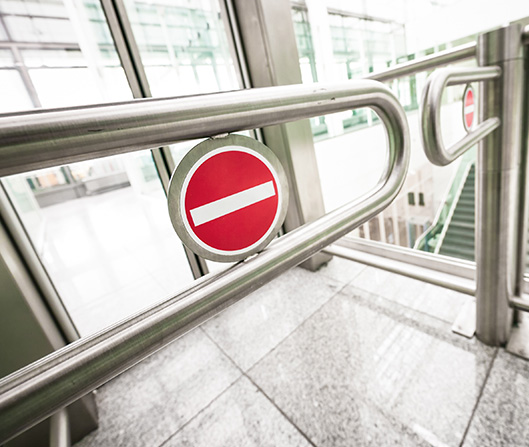What is turnstile access control?

01 March 2019

Designed to work
seamlessly with the ebb and flow of people in and out of a building, turnstile
access control should be as unobtrusive as it is effective. While turnstile
gates and barriers exist to keep unauthorised individuals out, they should also
be as practical as possible for those with the right access.
We’ve gathered the
basics on turnstile access control systems to act as an introduction to this
physical security technology.
What are turnstiles?
Access control
turnstiles automatically regulate entry to a designated building or area,
usually on a one-by-one basis. Most turnstile gates require only low power to
work, so can be installed with safe operating voltage.
Unmanned turnstile
systems can be programmed to admit access only to those with specific security
information or credentials, without the need for human intervention.
What are turnstiles used for?
As the actual barrier
hardware that either admits or refuses access to a space, turnstile
gates control not only who can pass through them, but how many at a
time. Depending on where they are installed, access control turnstiles of
different types and sizes can be used to admit pedestrians or vehicles.
Turnstile systems can
be surprisingly versatile. Switching turnstile operating modes can change their
function from allowing single passage in one direction to single passage in
both, from locked in both directions, to free passage in either one or both directions.
A lock chamber access mode can add a level of video or biometric verification
to a turnstile for extra security.
What types of turnstile entry systems
are there?
As automated
technologies have become more advanced over time, so too have turnstile gate
entry systems. Not only is there a range of turnstile barrier types to suit
different spaces and access control requirements, turnstiles can be integrated
with peripheral or wider security systems in order to further verify entry
permission.
Types of turnstile gates
Waist height pedestrian turnstile
gates : One of the most common
types of access control turnstile, waist height pedestrian gates can take the
form of a revolving tripod, rising arm, sliding or rotating barrier to ensure
only one person passes through at once. Once access is granted, some waist
height turnstile types require the person passing through to push the barrier
out of the way (such as tripod barriers), while others automatically open to
allow entry.
Full height pedestrian turnstile
gates: Offering a higher
level of physical security, full height turnstile gates are much more difficult
to pass through without clearance. Traditional revolving doors offer a form of
access control simply by limiting the number of people who can enter and exit,
glass security or ‘airlock’ portals close on one side before opening on the
other.
Optical pedestrian turnstiles: Capable of regulating
access without any kind of physical barrier, optical turnstiles work by
monitoring people who pass through with ID cards or badges using infrared light
beams. If an optical turnstile detects an unauthorised entry, the system raises
an alarm or signal.
Vehicle access control turnstiles: Barriers with lifting
boom arms control access for vehicles as they move in and out of car parks,
toll roads and bridges. Arms can be fitted with chain or ladder-style barrier
skirts that prevent pedestrians ducking under vehicle turnstiles.
Types of turnstile security integration
Biometric: Biometric turnstiles admit entry based on specific and
unique traits, such as fingerprinting, iris recognition and voice control.
Barcode / magnetic stripe: With barcode or
magnetic stripe readers, this type of turnstile gate requires users to present
and scan an ID card or badge.
Proximity readers: Proximity readers work
in a similar way to barcode and magnetic stripe readers, but are able to ‘read’
an ID card or badge once it is nearby, without the user having to insert or
swipe it.
Key pads: Key pad turnstile
gates work when users enter a PIN or access code.
Where are turnstiles used?
Access control systems
can be used in any location where there’s a need to regulate pedestrian or
vehicle flow. Building security is just one reason to install turnstile gates;
there are several other benefits and use cases for this type of access control.
For example, office
and commercial organisations may use turnstile gates to monitor visitor access or,
if they are integrated with an automated time and attendance system,
to manage employee working hours and time on-site.
Leisure facilities and entertainment venues may have a different turnstile access control remit; in
most cases to regulate the amount of people who can move from one area to
another at once.
For high-security premises, such as airports, integrated
turnstile gates can act as an extra security measure as well as a means of
passenger separation.
Let turnstile access systems enable
your business to take back control
As part of a
comprehensive access control system, turnstile gates offer a simple yet
effective way to increase security and manage crowd flow. To find out more
about our turnstile gate systems and how they can benefit your organisation, please
don’t hesitate to get in touch.
ABOUT THE AUTHOR - LYNDEN JONES

Lynden joined Touchstar ATC (formally Feedback Data) in a sales role for Access Control in 2010. Prior to joining the company, Lynden held both Production and Account Manager roles, gaining wide technical and commercial experience within the electronics market.
In 2013 Lynden was promoted to Sales Director and in 2017 he took overall responsibility of the business as Managing Director. As well as running Touchstar ATC, Lynden still remains extremely active in the sales and key account management aspects of the business. When not involved in the business, Lynden is a keen performance car enthusiast.